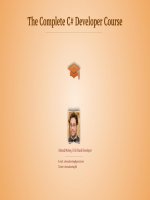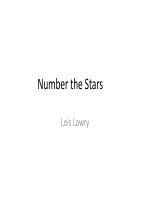Lecture 7 functions tủ tài liệu training
Bạn đang xem bản rút gọn của tài liệu. Xem và tải ngay bản đầy đủ của tài liệu tại đây (419.1 KB, 12 trang )
Lecture 7 - FUNCTIONS
Functions perform a certain task as the name suggests.
Why use functions?
The divide-and-conquer approach
It makes program development more manageable by constructing programs from
small, simple pieces.
Software reusability
Using existing functions as building blocks to create new programs.
Avoids repeating code.
Dividing a program into meaningful functions makes the program easier to debug
and maintain.
Any portion of the code that carries out a specific task or is to be repeated
several times can be converted into a function.
For example, the summing operation takes 2 inputs and returns their sum as
output.
sum() function can be called every time to calculate the sum.
Page | 1
Functions are invoked by a function call
A function call specifies the function name and provides information (as arguments) that
the called function needs
Boss to worker analogy:
A boss (the calling function or caller) asks a worker (the called function) to perform a
task and return (i.e., report back) the results when the task is done.
Function Definitions
Only written once
These statements are hidden from other functions.
Boss to worker analogy:
The boss does not know how the worker gets the job done; he just wants it done.
Syntax
Preprocesssor lines
function1 prototype;
//function prototype
function2 prototype;
int main( )
{
call function1();
//function call
call function2();
……
}
int function1( )
{
//function definition
//function body
……
}
int function2( )
{
……}
Page | 2
Syntax Explanation
•
•
•
Function Prototype ( Declaration)
– Tells the compiler that a function of this kind is defined somewhere in the
program.
Function Call
– Takes the program control to the called function.
Function Header and Body
– Contains the body of the function i.e. all the commands that make up the
function.
Example
#include <iostream>
using namespace std;
void sum(void);
//prototype
int main()
{
sum();
// sum call
return 0;
}
void sum(void)
{
float first, second;
cin >> first >>second;
//gets the seconds
cout << first + second;
// display the seconds
}
Page | 3
Differentiating Local and Global Variables
Scope
•
The life-time of variables exists within the variable’s scope.
•
After declaration, a variable can be referenced anywhere within its scope.
•
Every set of braces has its own scope, and can contain local variables.
•
The moment the set of braces in which a variable was declared ends, the
variable goes out of scope, i.e. it can no longer be referenced as an identifier.
•
A global variable’s scope lies throughout the program.
Page | 4
Example
#include <math.h>
// to perform math functions
void squareroot(float);
// function prototype
float z=0;
// global variable
int main(void)
{
float x;
x = 4.0;
z= 6.0;
squareroot(x);
//function call
squareroot(z);
}
void squareroot( float a)
{
static float y;
// local variable
y = y+sqrt(a)
// sqrt() is a built in function to get square root in the
cout <<"The answer = " << y <
//math.h library
//no error because static variables
// are set to zero by default
}
Page | 5
Inline Functions
•
Request to the compiler to insert the function body in the program where it is
called
– Saves time in function calls
main()
main()
Repeated
code
placed in
functions
Page | 6
……..
…………
…………
Func1()
;
…………
…………
Func2()
;
............
Func1
()
{……..}
Func2
()
{……..}
……..
…………
…………
Func1()
{…….
…………}
…………
Func2()
{...........
..
………….
}
Repeated
code
placed
Important Points about Functions
•
It should be noticed that the prototype is written before the main () function. This
cause the prototype to be visible to all the functions in a file.
•
The presence of ; should be noted carefully .
•
The arguments and return type must match to the corresponding variable types
of the prototype and definition.
•
Note that you can only return one value from a function, however you can pass
several values to a function.
•
If we want to return more than one value from a function then we have to use
pointers.
•
We can pass constants as well as variable to the functions.
Page | 7
QUIZ
Short Questions
1. A function’s single most important role is to
a. give a name to a block of code.
b. reduce program size.
c. accept arguments and provide a return value.
d. help organize a program into conceptual units.
2. A function itself is called the function d_________.
3. Write a function called foo() that displays the word foo.
4. A one-statement description of a function is referred to as a function d_________ or a
p_________.
5. The statements that carry out the work of the function constitute the function
_________.
6. A program statement that invokes a function is a function _________.
7. The first line of a function definition is referred to as the _________.
8. A function argument is
a. a variable in the function that receives a value from the calling program.
b. a way that functions resist accepting the calling program’s values.
c. a value sent to the function by the calling program.
d. a value returned by the function to the calling program.
9. True or false: When arguments are passed by value, the function works with the
original arguments in the program.
10. What is the purpose of using argument names in a function declaration?
11. Which of the following can legitimately be passed to a function?
a. A constant
b. A variable
c. A structure
d. A header file
12. What is the significance of empty parentheses in a function declaration?
13. How many values can be returned from a function?
14. True or false: When a function returns a value, the entire function call can appear on
the right side of the equal sign and be assigned to another variable.
15. Where is a function’s return type specified?
16. What functions can access a global variable that appears in the same file with
them?
17. What functions can access a local variable?
18. A static local variable is used to
a. make a variable visible to several functions.
b. make a variable visible to only one function.
c. conserve memory when a function is not executing.
d. retain a value when a function is not executing.
Page | 8
Exercise
1. Write a function called circarea() that finds the area of a circle in a similar way. It
should take an argument of type float and return an argument of the same type.
Write a main() function that gets a radius value from the user, calls circarea(),
and displays the result.
2. Raising a number n to a power p is the same as multiplying n by itself p times.
Write a function called power() that takes a double value for n and an int value for
p, and returns the result as a double value. Use a default argument of 2 for p, so
that if this argument is omitted, the number n will be squared. Write a main()
function that gets values from the user to test this function.
3. Write a function called zeroSmaller() that is passed two int arguments by
reference and then sets the smaller of the two numbers to 0. Write a main()
program to exercise this function.
Page | 9
Answers
Short Questions
1. d
2. definition
3.
void foo()
{
cout << “foo”;
}
4. declaration, prototype
5. body
6. call
7. declarator
8. c
9. false
10. To clarify the purpose of the arguments
11. a, b, c
12. Empty parentheses mean the function takes no arguments
13. one
14. Ttrue
15. at the beginning of the declaration and declaratory
16. those functions defined following the variable definition
17. the function in which it is defined
18. b, d
Page | 10
Exercise
Answers
1.
// function finds area of circle
#include <iostream>
using namespace std;
float circarea(float radius);
int main()
{
double rad;
cout << “\nEnter radius of circle: “;
cin >> rad;
cout << “Area is “ << circarea(rad) << endl;
return 0;
}
//-------------------------------------------------------------float circarea(float r)
{
const float PI = 3.14159F;
return r * r * PI;
}
2.
// function raises number to a power
#include <iostream>
using namespace std;
double power( double n, int p=2); //p has default value 2
int main()
{
double number, answer;
int pow;
char yeserno;
cout << “\nEnter number: “; //get number
cin >> number;
cout << “Want to enter a power (y/n)? “;
cin >> yeserno;
if( yeserno == „y‟ ) //user wants a non-2 power?
{
cout << “Enter power: “;
cin >> pow;
answer = power(number, pow); //raise number to pow
}
else
answer = power(number); //square the number
cout << “Answer is “ << answer << endl;
return 0;
}
//-------------------------------------------------------------// power()
// returns number n raised to a power p
double power( double n, int p )
{
double result = 1.0; //start with 1
Page | 11
for(int j=0; j
return result;
}
3.
// function sets smaller of two numbers to 0
#include <iostream>
using namespace std;
int main()
{
void zeroSmaller(int&, int&);
int a=4, b=7, c=11, d=9;
zeroSmaller(a, b);
zeroSmaller(c, d);
cout << “\na=” << a << “ b=” << b
<< “ c=” << c << “ d=” << d;
return 0;
}
//-------------------------------------------------------------// zeroSmaller()
// sets the smaller of two numbers to 0
void zeroSmaller(int& first, int& second)
{
if( first < second )
first = 0;
else
second = 0;
}
Page | 12









